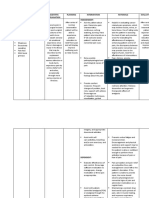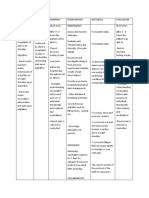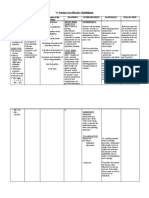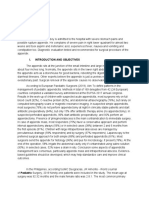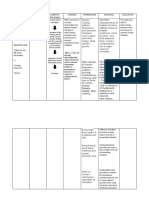Nursing Care Plan - Acute Pain Assessment Diagnosis Scientific Rationale Planning Intervention Rationale Evaluation
Nursing Care Plan - Acute Pain Assessment Diagnosis Scientific Rationale Planning Intervention Rationale Evaluation
Uploaded by
Nicole cuencosCopyright:
Available Formats
Nursing Care Plan - Acute Pain Assessment Diagnosis Scientific Rationale Planning Intervention Rationale Evaluation
Nursing Care Plan - Acute Pain Assessment Diagnosis Scientific Rationale Planning Intervention Rationale Evaluation
Uploaded by
Nicole cuencosOriginal Description:
Original Title
Copyright
Available Formats
Share this document
Did you find this document useful?
Is this content inappropriate?
Copyright:
Available Formats
Nursing Care Plan - Acute Pain Assessment Diagnosis Scientific Rationale Planning Intervention Rationale Evaluation
Nursing Care Plan - Acute Pain Assessment Diagnosis Scientific Rationale Planning Intervention Rationale Evaluation
Uploaded by
Nicole cuencosCopyright:
Available Formats
Nursing care plan – Acute pain
Assessment Diagnosis Scientific rationale Planning Intervention Rationale Evaluation
Subjective: Acute pain related Colonization of E- Discharge outcome: Independent: Goal achieved:
“Sobrang to inflammation of COLI in the urethra/
sakit po kapag the urinary tract as cervix/ bladder After 3 days of nursing 1. Perform pain To demonstrate The client pain is relieved and
umiihi ako” as evidenced by intervention the client assessment each improvement in status controlled
verbalized by burning pain in will report pain is time pain occurs. or to identify worsening
theclient urination relieved or controlled of underlying condition, The client was able to
Ascension to the developing demonstrate relaxation skills and
Objective: bladder Short term outcome: complications diversional activities such as.
-Fever Focused breathing, visualization,
-Abdominal After 2 hours of guided imagery
pain nursing intervention 2. Encouraged To Increased hydration
-Dysuria Increase in the patient will increased oral fluid helps in flushing the
(Burning pain) neutrophil demonstrate 1-2 intake (2-3 liters if no bacteria and toxins.
-presence of relaxation skills and contraindications.
hematuria diversional activities
-urinary 3 Provide additional Improves circulation,
urgency, Inflammatory comfort measures reduces, reduces mucle
hesistancy response such as backrub and tension and anxiety
and anuria heat or cold associated with pain
-Flank/back applications
pain
-vomiting
-Facial Prostaglandin
grimace release 4. Use puppets to To enhance
-pain scale demonstrate understanding and
8/10 procedure for child. reduce level of anxiety
and fear
Burning pain during 5. Encourage To evaluate coping
urination verbalization of abilities and to identify
feelings about the areas of additional
pain such as concern
about tolerating pain, concern.
anxiety, pessimistic
thoughts.
Collaborative:
1. identify specific s/s
and changes in pain It provides opportunities
characteristic to modify pain
requiring medical management regimen
follow up. and allows for timely
intervention for
developing
complications.
2. provide for
individualized Promotes active, rather
physical therapy or than passive, role and
exercise program enhances sense of
that can be control.
continued by the
client after discharge
References:
Marilynn E. Doenges,
Marry Frances
Moorhouse, Alice C.
murr nurse’s pocket
guide diagnoses,
prioritized
interventions, and
rationales Pages 602 -
605
You might also like
- Growth in The Aging Craniofacial Skeleton / by Rolf Gordon BehrentsDocument169 pagesGrowth in The Aging Craniofacial Skeleton / by Rolf Gordon Behrentsegray797No ratings yet
- NURSING CARE PLAN of Hodgkin's Lymphoma: Assessment Nursing Diagnosis Planning Nursing Interventions Rationale EvaluationDocument5 pagesNURSING CARE PLAN of Hodgkin's Lymphoma: Assessment Nursing Diagnosis Planning Nursing Interventions Rationale Evaluationjoyrena ochondraNo ratings yet
- Fdar-Labor PainDocument5 pagesFdar-Labor PainNicole cuencos100% (1)
- Schizophrenia NCPDocument2 pagesSchizophrenia NCPNicole cuencos100% (3)
- Computation FormulasDocument1 pageComputation FormulasNicole cuencosNo ratings yet
- Animal Science RefresherDocument322 pagesAnimal Science RefresherXwEet CuRi57% (7)
- NCPDocument6 pagesNCPAndrea Marie SevillaNo ratings yet
- Kusain - NCP in NCM 112 RleDocument2 pagesKusain - NCP in NCM 112 Rlejay kusainNo ratings yet
- Gouty NCPDocument9 pagesGouty NCPKrishelle Kate PannigNo ratings yet
- Assessment Diagnosis Scientific Basis Planning Nursing Interventions Rationale EvaluationDocument3 pagesAssessment Diagnosis Scientific Basis Planning Nursing Interventions Rationale EvaluationGj PaguidianNo ratings yet
- NCP Acute PainDocument3 pagesNCP Acute PainGeorge FogNo ratings yet
- NCP Acute PainDocument2 pagesNCP Acute PainMillicent Faye G. Gelit50% (2)
- Neri, Angela - Act. 1,2,3Document5 pagesNeri, Angela - Act. 1,2,3Angela NeriNo ratings yet
- NCP Pain 1Document6 pagesNCP Pain 1goodemonz15No ratings yet
- Di Ko To Sure Kung Tama Yung Rel To Disease ProcessDocument8 pagesDi Ko To Sure Kung Tama Yung Rel To Disease ProcessNyeam NyeamNo ratings yet
- "I Don't Have An Infection in My Gallbladder Which Is Good, But I Do Feel The Pain," As Verbalized by TheDocument2 pages"I Don't Have An Infection in My Gallbladder Which Is Good, But I Do Feel The Pain," As Verbalized by Theunnamed person100% (1)
- Actual NCPDocument10 pagesActual NCPRouie Björn ABrianNo ratings yet
- Nursing Care Plan For Soft Tissue InjuryDocument2 pagesNursing Care Plan For Soft Tissue InjuryGian Delos SantosNo ratings yet
- NCP Charm EditedDocument6 pagesNCP Charm EditedampogeNo ratings yet
- Nursing Care PlanDocument19 pagesNursing Care Planabigail gogoNo ratings yet
- Assessments Nursing Diagnosis Planning Interventions Rationale EvaluationDocument12 pagesAssessments Nursing Diagnosis Planning Interventions Rationale EvaluationAsniah Hadjiadatu AbdullahNo ratings yet
- NCP LymphomaDocument3 pagesNCP Lymphomamahmoud fuqahaNo ratings yet
- PainDocument2 pagesPainpaulahhhNo ratings yet
- AssessmentDocument3 pagesAssessmentJemma GandaNo ratings yet
- Nursing Care PlanDocument2 pagesNursing Care PlanRhenelyn Delos ReyesNo ratings yet
- NCP Sas 10Document2 pagesNCP Sas 10Shyn MargarethNo ratings yet
- NCPDocument4 pagesNCPfairwoods90% (10)
- Typhoid Fever NCPDocument46 pagesTyphoid Fever NCPLyra Lustre RN67% (3)
- NCP Post Op AppendectomyDocument3 pagesNCP Post Op AppendectomyHakam Attawneh100% (2)
- NCPDocument6 pagesNCPKrishna Faith P. DelaraNo ratings yet
- Assessment Diagnosis Planning Interventions Evaluation Nsg. Action RationaleDocument2 pagesAssessment Diagnosis Planning Interventions Evaluation Nsg. Action RationaleRhea Mae Valles - ReyesNo ratings yet
- NCPDocument5 pagesNCPAthea Melosantos100% (1)
- Emmy's NCP and EtcDocument7 pagesEmmy's NCP and EtcabraNo ratings yet
- NCP Colorectal CancerDocument4 pagesNCP Colorectal CancerWinnie AriolaNo ratings yet
- NCPDocument8 pagesNCPAriaNo ratings yet
- Nursing Care Plan: List Priority Nursing DiagnosisDocument2 pagesNursing Care Plan: List Priority Nursing DiagnosisLen meloNo ratings yet
- Assessment Nursing Diagnosis Scientific Explanation Planning Intervention Rationale Evaluation IndeoendentDocument3 pagesAssessment Nursing Diagnosis Scientific Explanation Planning Intervention Rationale Evaluation IndeoendentDiane Sarino CabonceNo ratings yet
- NCP DR 1Document2 pagesNCP DR 1jay kusainNo ratings yet
- Observation:: Short Term Goal: Short Term GoalDocument3 pagesObservation:: Short Term Goal: Short Term GoalGiselle EstoquiaNo ratings yet
- Nursing Care Plan Assessment Diagnosis Inference Planning Interventio N Rationale EvaluationDocument3 pagesNursing Care Plan Assessment Diagnosis Inference Planning Interventio N Rationale EvaluationDianne100% (3)
- Labor Pain NCPDocument4 pagesLabor Pain NCPBea Dela Cena60% (5)
- Carreon-Ncp M3Document4 pagesCarreon-Ncp M3Denniella Marie CarreonNo ratings yet
- NCP Acute PainDocument3 pagesNCP Acute PainBasema HashhashNo ratings yet
- Acute Pain Due To Labor Process NCPDocument1 pageAcute Pain Due To Labor Process NCPRhod Vincent Jamolod TayongNo ratings yet
- Actual NCP - RabiesDocument2 pagesActual NCP - RabiesDenice Tamayo De GuzmanNo ratings yet
- Case 6 QUESTIONSDocument10 pagesCase 6 QUESTIONSEduard GarchitorenaNo ratings yet
- XVII. Nursing Care Plan Assessment Inference Nursing Diagnosis Planning Intervention Rationale EvaluationDocument3 pagesXVII. Nursing Care Plan Assessment Inference Nursing Diagnosis Planning Intervention Rationale EvaluationAthena SaturdayNo ratings yet
- NCP FractureDocument7 pagesNCP FractureMacris BondocNo ratings yet
- NCP CholelithiasisDocument6 pagesNCP CholelithiasisWendy Hingpit RonquilloNo ratings yet
- Nursing Care Plan2Document3 pagesNursing Care Plan2Fc CrisostomoNo ratings yet
- Escoton, Kate Angel P (NCP)Document4 pagesEscoton, Kate Angel P (NCP)Kate EscotonNo ratings yet
- ASSESSMENTDocument2 pagesASSESSMENTRhelina MinNo ratings yet
- NCP (Appendectomy)Document3 pagesNCP (Appendectomy)Joyce Anne Lambiquit RN100% (2)
- NCP Severe Labor PainDocument3 pagesNCP Severe Labor PainPaolo EspinosaNo ratings yet
- NCP NephrolithiasisDocument3 pagesNCP NephrolithiasisMANUEL EMERSONNo ratings yet
- NCP Threatened AbortionDocument5 pagesNCP Threatened AbortionKceey CruzNo ratings yet
- NCP Compilation 1.1Document8 pagesNCP Compilation 1.1Cristelle Joy RebocaNo ratings yet
- Nursing Care Plan For CholecystitisDocument4 pagesNursing Care Plan For CholecystitisEemyaj Jaymee89% (9)
- PYELONEPHRITISDocument6 pagesPYELONEPHRITISBb RabbitNo ratings yet
- Acute Pain Colon CaDocument2 pagesAcute Pain Colon CaJassel EscobarNo ratings yet
- NCP DiverticulitisDocument6 pagesNCP DiverticulitisLovely Cacapit100% (1)
- Care PlanDocument2 pagesCare PlanAnonymous 9QBCcNNo ratings yet
- The Art of Holistic Pain Management: A Practical HandbookFrom EverandThe Art of Holistic Pain Management: A Practical HandbookNo ratings yet
- Pathophysiology CLEFT LIP AND CLEFT PALATEDocument2 pagesPathophysiology CLEFT LIP AND CLEFT PALATENicole cuencosNo ratings yet
- Weigght Gain NCPDocument1 pageWeigght Gain NCPNicole cuencosNo ratings yet
- Case Ana-Hypothyroidism 2020Document7 pagesCase Ana-Hypothyroidism 2020Nicole cuencosNo ratings yet
- Labor Pain Case StudyDocument7 pagesLabor Pain Case StudyNicole cuencosNo ratings yet
- Depression Case StudyDocument1 pageDepression Case StudyNicole cuencos50% (2)
- COLON CANCER NCP-impaired nutrITIONDocument3 pagesCOLON CANCER NCP-impaired nutrITIONNicole cuencosNo ratings yet
- APPENDIC CASES Cuenco2020Document3 pagesAPPENDIC CASES Cuenco2020Nicole cuencosNo ratings yet
- NCP - Impaire Urinary EliminationDocument3 pagesNCP - Impaire Urinary EliminationNicole cuencosNo ratings yet
- Spinal Bifida Ncp-Impaired Physical MobilityDocument3 pagesSpinal Bifida Ncp-Impaired Physical MobilityNicole cuencos50% (2)
- Drug Classification/Indicati ON Mechanis MOF Action Contraindication Adverse Reaction Dose, Route, Frequenc Y Nursing Responsibiliti ESDocument5 pagesDrug Classification/Indicati ON Mechanis MOF Action Contraindication Adverse Reaction Dose, Route, Frequenc Y Nursing Responsibiliti ESNicole cuencosNo ratings yet
- Nursing Care Plan: Subjective CuesDocument2 pagesNursing Care Plan: Subjective CuesNicole cuencosNo ratings yet
- Deficient Fluid Volume Related To Polyuria and Dehydration AEB Dry Mucus MembraneDocument1 pageDeficient Fluid Volume Related To Polyuria and Dehydration AEB Dry Mucus MembraneNicole cuencosNo ratings yet
- Alteration of The Starling Forces Which Control Transfer of Fluid From The Vascular Compartment To Surrounding Tissue SpacesDocument3 pagesAlteration of The Starling Forces Which Control Transfer of Fluid From The Vascular Compartment To Surrounding Tissue SpacesNicole cuencosNo ratings yet
- Duavent Drug StudyDocument2 pagesDuavent Drug StudyNicole cuencosNo ratings yet
- Top Communicable Diseases in The Philippines 2019Document4 pagesTop Communicable Diseases in The Philippines 2019Nicole cuencosNo ratings yet
- Significance of The Study & Scope, Limitations and Delimitations-HIV2019Document1 pageSignificance of The Study & Scope, Limitations and Delimitations-HIV2019Nicole cuencosNo ratings yet
- Halid ProposalDocument15 pagesHalid Proposaltirunehawoke8No ratings yet
- Affection of Salivary GlandsDocument16 pagesAffection of Salivary GlandsAdarshBijapurNo ratings yet
- Circulatory SystemDocument20 pagesCirculatory SystemrosemieannelumboanNo ratings yet
- TIEDocument4 pagesTIEIrwandi MuslimNo ratings yet
- Specialty 2015 TrophiesDocument3 pagesSpecialty 2015 Trophiesapi-282548358No ratings yet
- Protozoa PowerpointDocument36 pagesProtozoa PowerpointHarriza Macapundag Haron-GangcoNo ratings yet
- G.V. Black Caries Classification (Class I To VI)Document2 pagesG.V. Black Caries Classification (Class I To VI)Madhusmita SahuNo ratings yet
- Units 65,66,69,70Document31 pagesUnits 65,66,69,70saratorabianNo ratings yet
- Thyroid Gland Function in Ovariectomized Ewes Exposed To PhytoestrogensDocument7 pagesThyroid Gland Function in Ovariectomized Ewes Exposed To PhytoestrogensAhmad Daud OmNo ratings yet
- Csec HSB January 2008 p2Document21 pagesCsec HSB January 2008 p2Sachin BahadoorsinghNo ratings yet
- Delivery of The Aftercoming HeadDocument7 pagesDelivery of The Aftercoming HeadHendri KunNo ratings yet
- RickettsiaDocument3 pagesRickettsiaFeroz MamunNo ratings yet
- SSC CGL Special Edition General Awareness NotesDocument130 pagesSSC CGL Special Edition General Awareness NotesRajdeepSenNo ratings yet
- Dragon #92 - Ecology of The EttinDocument3 pagesDragon #92 - Ecology of The EttinGeorge KrashosNo ratings yet
- Work Sheet No 4 of Class 11thDocument2 pagesWork Sheet No 4 of Class 11thshakifa054No ratings yet
- Capillaria PhilippinensisDocument19 pagesCapillaria PhilippinensisPaul Avila SorianoNo ratings yet
- Anatomy and Histology of The Denture Bearing AreaDocument6 pagesAnatomy and Histology of The Denture Bearing AreaYordies Carn Yung Coi0% (2)
- Nasopharyngeal CarcinomaDocument25 pagesNasopharyngeal Carcinomananda surastyo100% (1)
- Presentation Bull MastiffDocument91 pagesPresentation Bull Mastiffjorgefernando98100% (1)
- Coenurus CerebalisDocument13 pagesCoenurus Cerebalisalhikma printingNo ratings yet
- Human CD ChartDocument1 pageHuman CD ChartcoffeeaddictedNo ratings yet
- Anatomical TerminologyDocument5 pagesAnatomical TerminologyShereen AlobinayNo ratings yet
- NCP GbsDocument2 pagesNCP GbsJaylord VerazonNo ratings yet
- Summary of Muscular System 4Document4 pagesSummary of Muscular System 4api-253866502100% (1)
- Digestive Structured Questions BIO095Document2 pagesDigestive Structured Questions BIO095Izzuddin Ghani100% (1)
- The Cydonian Pyramid by Pete Hautman - Sample ChapterDocument31 pagesThe Cydonian Pyramid by Pete Hautman - Sample ChapterCandlewick PressNo ratings yet
- Legacy - Life Among The Ruins (2nd Edition) - Handout SheetsDocument95 pagesLegacy - Life Among The Ruins (2nd Edition) - Handout SheetsGraydon Lea75% (4)
- Chimpanzees ParagraphDocument3 pagesChimpanzees Paragraphapi-202117663No ratings yet




































